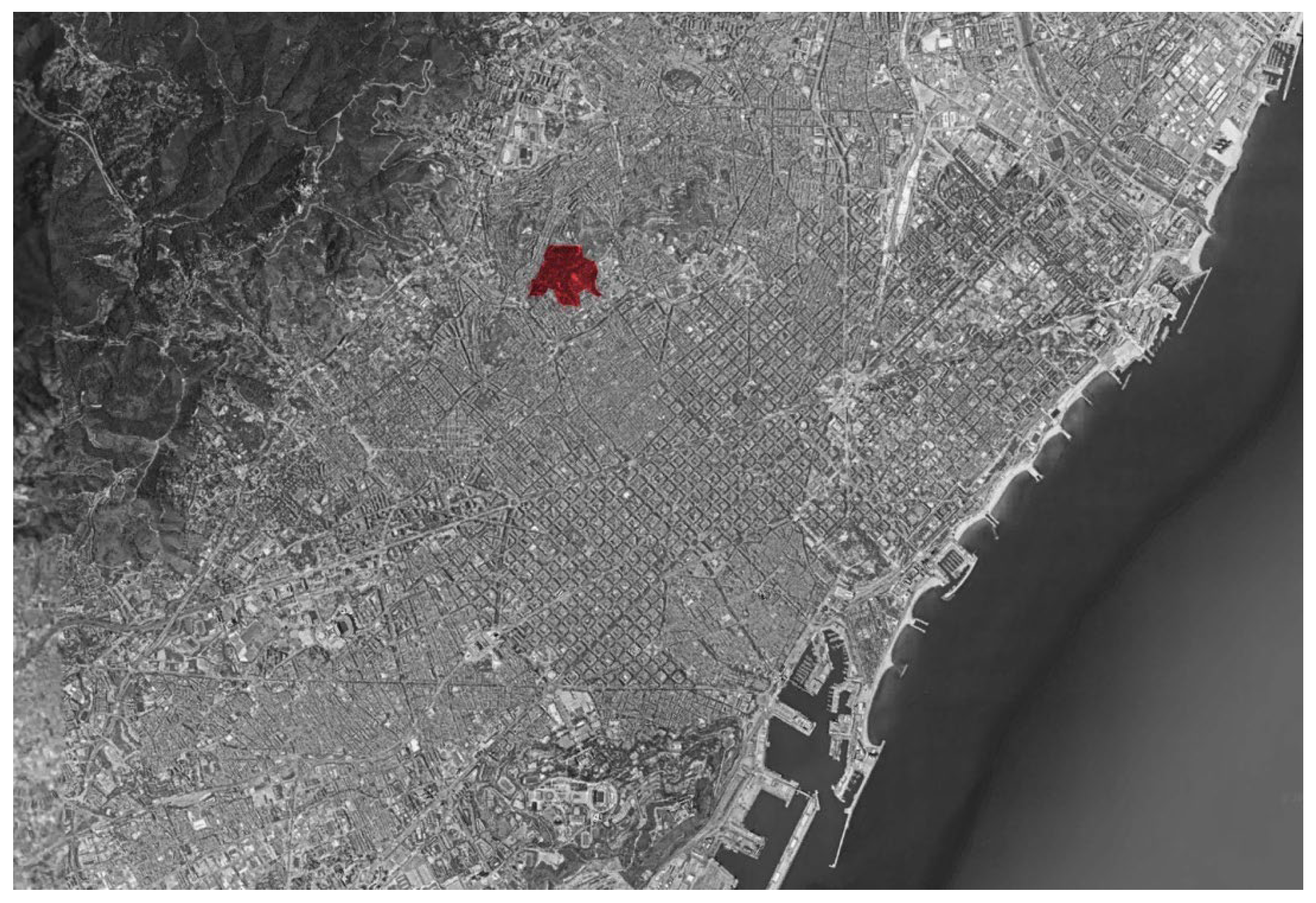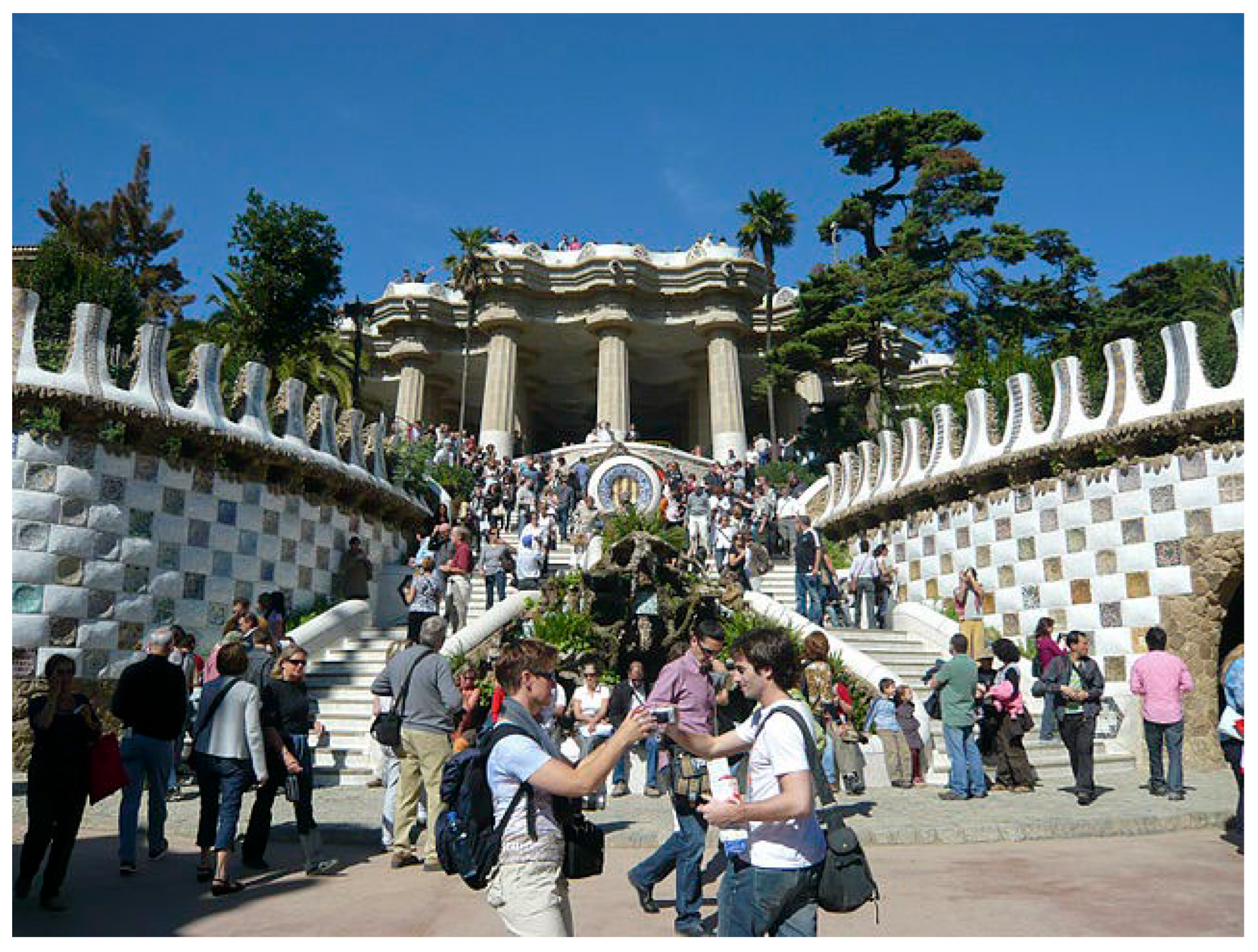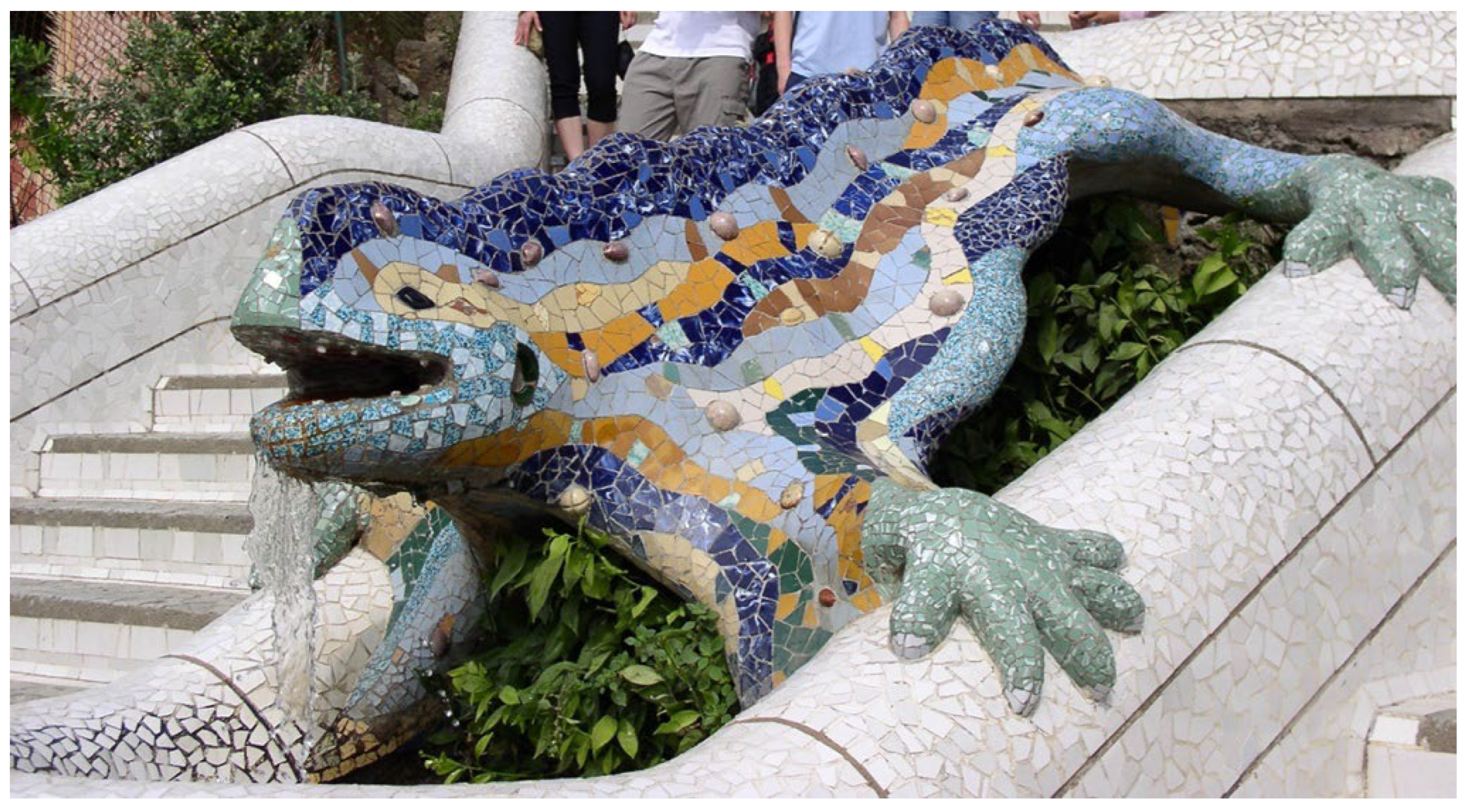RETRACTED: The Commodification Dilemma: Tourism Pressure and Heritage Conservation in Barcelona
Abstract
1. Introduction
UNESCO’s policies appear paradoxical—while they attempt to preserve the multiplicity of local cultural traditions perceived to be under threat by the forces of globalisation, the resulting heritage regime itself seems to act as a homogenising machine, objectifying and classifying distinct cultural forms as heritage and others not.
2. Materials and Methods
3. Results
The Case of Park Güell
ICOMOS would, however, call attention to the necessity of assuring the preservation of the whole of this exceptional work by Gaudí, which is now threatened because of the fragility of some of its materials (in particular the ceramic facings).
En el plan especial de protección del parque Güell deberá resolver no únicamente el deterioro concreto de la obra de Gaudí, sino también problemas en sus accesos y el destino de la escuela Baldiri Reixac. Este centro escolar se encuentra en pésimas condiciones y con déficit de espacio para un centro de EGB. Una de las posibles soluciones es la construcción de un nuevo colegio fuera del recinto del parque Güell.
Por parte de la Generalitat nada se ha hecho en ningún sentido, siendo normal que también contribuyera a la restauración de un monumento archivisitado y conocido en todo el mundo. Mientras tanto, la escuela municipal Baldiri Reixac continúa en la antigua casa que fuera de don Eusebio Güell cuando lo lógico es que fuera desplazada a otro lugar para proceder al arreglo del edificio y a liberar al parque de la inevitable degradación que supone la existencia de un edificio público tan concurrido. Si la escuela es trasladada, ha de ser con la condición de que se inicie inmediatamente el arreglo y acondicionamiento del edificio para museo o centro cultural.
Seguramente ninguno de los cuatrocientos monumentos restantes del Patrimonio Mundial de la UNESCO merece este olímpico desprecio institucional. El oro corre a raudales en Barcelona en la feliz ocasión de los Juegos Olímpicos del 1992, pero el parque Güell sigue abandonado y escarnecido. (…) el Parque Güell recibirá en 1992 mucho más visitantes que el estadio olímpico (…). Pensar que el parque Güell es un simple jardín público urbano, un lugar para juegos incontrolados de la chiquillería depredadora, refugio de drogadictos, casi una zona suburbial, es un error tan grave que casi no cabe en cabeza humana (…). Se impone un rápido cambio de actitud de las instituciones hacia el parque Güell, si no quieren que Barcelona sea, además que la sede olímpica del 1992, la ciudad insensible u poco civilizada, que sume en el abandono una de sus más altas y singulares joyas artísticas.
Volete rilanciare il turismo, attirando visitatori (e soldi) in una città? Puntate sull’architettura. È il messaggio, esplicito, che si coglie leggendo sulle pagine del País i resoconti dell’anno gaudiano da poco concluso e promosso per il 150 mo anniversario della nascita dell’architetto catalano Antoni Gaudí. “Per Barcellona è stato uno degli avvenimenti di maggior successo, dopo i giochi olimpici del 1992”, ha dichiarato con non poca soddisfazione il ministro della cultura Ferran Mascarell. E, dati alla mano, non si può dargli torto: in un anno sono stati 6 milioni i turisti che hanno affollato gli oltre 300 eventi del fitto cartellone o visitato gli edifici del maestro catalano. Un conteggio che contempla i soli appuntamenti a pagamento. Senza considerare che le celebrazioni hanno portato con sé una serie di importanti interventi di restauro e recupero dei monumenti e l’apertura al pubblico di alcuni edifici, come la Casa Batlló, che rimarrà visitabile anche per tutto il 2003. (…) Monetizzando, si parla di introiti per oltre 47 milioni di euro, 14 dei quali generati grazie al solo “anno di Gaudí”. Obiettivo raggiunto. “Dimostrato il buon risultato degli anni tematici, continueremo anche in futuro”, ha commentato Mascarell, “Barcellona ha fatto un salto di qualità e si è imposta all’attenzione internazionale come città di architettura e cultura”.
Todo este preámbulo es para razonar mejor la salvajada cometida en el Park Güell. Esta obra de Gaudí debería haber sido, desde hace mucho tiempo, considerada como un museo y obrar en consecuencia. Las alertas dadas por vecinos y usuarios sobre la violencia que los gamberros han ejercido allí no han sido atendidas, pese a que por desgracia se habían detectado algunas agresiones. (…) Y lo irremediable fatalmente ha sobrevenido. Espero que este desmán obligue a actuar pronto y en serio. El Park Güell es único y no puede estar al albur de los sinvergüenzas. Se impone una protección inmediata, máxime ahora que sufre la multiplicación de visitantes.
Abans de fer propostes en la taula d’un despatx, com sempre, l’Ajuntament hauria de pensar una mica més en els nadius d’aquesta Barcelona cada cop més abocada a ser un Descamisats Thematic Park.
El Parc Güell rep una pressió de públic molt important atès el seu valor arquitectònic. Es tracta d’una de les obres emblemàtiques de Gaudí per la idea de ciutat que conté. La seva gestió ha de contemplar alhora la doble vessant de parc i zona verda d’ús veïnal i la consideració d’espai patrimonial protegit. Demanem que es consideri la possibilitat de posar mesures que ordenin les aglomeracions estacionals actuals, ponderant i preservant l’ús restrictiu. Proposem que una de les mesures estableixi el cobrament d’una entrada al recinte definit pel perímetre restringit acordat per la UNESCO.
4. Discussion
5. Conclusions
Author Contributions
Funding
Informed Consent Statement
Data Availability Statement
Acknowledgments
Conflicts of Interest
| 1 | The text literally says that “the Constitution of the Organization provides that it will maintain, increase, and diffuse knowledge by assuring the conservation and protection of the world’s heritage, and recommending to the nations concerned the necessary international conventions”. |
| 2 | We are referring here to the text of two versions of “The Operational Guidelines for the Implementation of the World Heritage Convention”, in 2002 and in 2007. |
| 3 | This article stems from a doctoral research thesis in progress that investigates the phenomenology of tourism pressure in Southern Europe. The thesis is supervised by Maurizio Carta (tutor) and Marco Picone (co-tutor), both from the University of Palermo. |
| 4 | This document is included in Albert Arias Sans’s thesis [36] as Annex 2.2. |
References
- Dodds, R.; Butler, R.W. (Eds.) The enablers of overtourism. In Overtourism Issues, Realities and Solutions, 1st ed.; De Gruyter Oldenbourg: Berlin, Germany, 2019; pp. 6–24. [Google Scholar]
- Koens, K.; Postma, A.; Papp, B. Is Overtourism Overused? Understanding the Impact of Tourism in a City Context. Sustainability 2018, 10, 4384. [Google Scholar] [CrossRef]
- Cocola-Gant, A. Tourism gentrification. In Handbook of Gentrification Studies; Lees, L., Philips, M., Eds.; Edward Elgar Publishing: Cheltenham, UK; Northampton, UK, 2018. [Google Scholar]
- Taş Gürsoy, I. Beauty and the Beast: A Fairy Tale of Tourismphobia. Tour. Plan. Dev. 2019, 16, 434–451. [Google Scholar] [CrossRef]
- Picascia, S.; Romano, A.; Teobaldi, M. The Airification of Cities: Making Sense of the Impact of Peer to Peer Short Term Letting on Urban Functions and Economy. In Proceedings of the Annual Congress of the Association of European Schools of Planning, Lisbon, Portugal, 11–14 July 2017. [Google Scholar]
- Söderström, O.; Mermet, A.C. When Airbnb Sits in the Control Room: Platform Urbanism as Actually Existing Smart Urbanism in Reykjavík. Front. Sustain. Cities 2020, 2, 15. [Google Scholar] [CrossRef]
- Zuelow, E.G.A. A History of Modern Tourism; Bloomsbury Publishing: London, UK, 2015; pp. 60–75. [Google Scholar]
- Benevolo, L. La Città Nella Storia d’Europa; Laterza: Rome, Italy, 2019. [Google Scholar]
- Rouhi, J. Development of the Theories of Cultural Heritage Conservation in Europe: A Survey of 19th and 20th Century Theories. In Proceedings of the 4th International Congress on Civil Engineering, Architecture & Urban Development, Tehran, Iran, 27–29 December 2016. [Google Scholar]
- Smith, N.D. The Railway and Its Passengers: A Social History; David and Charles: Newton Abbot, UK, 1988. [Google Scholar]
- O’Connor, J.; Wynne, D. From the Margins to the Centre: Cultural Production and Consumption in the Post-Industrial City; Routledge: London, UK, 2017. [Google Scholar]
- Ashworth, G.J.; Tunbridge, J.E. The Tourist-Historic City, 1st ed.; Routledge: London, UK, 2000. [Google Scholar]
- Judd, D.J.; Fainstein, S.S. The Tourist City; Yale University Press: Yale, CT, USA, 1999. [Google Scholar]
- Doxey, G.A. Causation Theory of Visitor–Resident Irritants, Methodology and Research Inferences: The Impact of Tourism. In Proceedings of the Sixth Annual Conference of the Travel Research Association, San Diego, CA, USA; 1975; pp. 8–11. [Google Scholar]
- Pizam, A. Tourism’s Impacts: The Social Costs to the Destination Community as Perceived by Its Residents. J. Travel Res. 1978, 16, 5–12. [Google Scholar] [CrossRef]
- Butler, R. The Concept of a Tourist Area Cycle of Evolution: Implications for Management of Resources. Can. Geogr. 1980, 1, 5–12. [Google Scholar] [CrossRef]
- Horne, D. The Great Museum. In The Re-Presentation of History; Pluto Press: London, UK, 1984. [Google Scholar]
- Lumley, R. The Museum Time-Machine; Routledge: London, UK, 1988. [Google Scholar]
- Wright, P. On Living in an Old Country; Verso: London, UK, 1985. [Google Scholar]
- Hewison, R. The Heritage Industry. In Britain in a Climate of Decline; Methuen: London, UK, 1987. [Google Scholar]
- Drach, A.; Cassis, Y. Financial Deregulation: A Historical Perspective; OUP Oxford: Oxford, UK, 2021. [Google Scholar]
- Prigent, L. Le patrimoine mondial est-il un mirage économique? Les enjeux contrastés du développement touristique. Téoros 2011, 30, 6–16. [Google Scholar] [CrossRef][Green Version]
- Prud’homme, R. Les Impacts Socio-Économiques de l’inscription d’un Site sur la Liste du Patrimoine Mondial: Trois Études. UNESCO Report. 2008. Available online: http://docplayer.fr/15236757-Les-impacts-socio-economiques-de-l-inscription-d-un-site-sur-la-liste-du-patrimoine-mondial-trois-etudes-1-remy-prud-homme-2.html (accessed on 23 June 2022).
- Marcotte, P.; Bourdeau, L. La promotion des sites du patrimoine mondial de l’UNESCO: Compatible avec le développement durable? Manag. Avenir. 2010, 34, 270–288. [Google Scholar] [CrossRef]
- D’Eramo, M. Il Selfie del Mondo Indagine Sull’età del Turismo; Feltrinelli Editore: Milan, Italy, 2017. [Google Scholar]
- Schramm, K. Heritage, Power and Ideology. In The Palgrave Handbook of Contemporary Heritage Research, 2nd ed.; Waterton, E., Watson, S., Eds.; Palgrave Macmillan: London, UK, 2015; pp. 442–457. [Google Scholar]
- De Ascaniis, S.; Gravari Barbas, M.; Cantoni, L. Tourism Management at UNESCO World Heritage Sites. UNESCO Uni Twin Report. 2018. Available online: https://lms.fun-mooc.fr/asset-v1:Paris1+16008+session01+type@asset+block@MOOC_TMatUWHS_manual.pdf (accessed on 23 June 2022).
- Hall, C. Dissonant heritage: The management of the past as a resource in conflict. Ann. Tour. Res. 1997, 24, 496–498. [Google Scholar] [CrossRef]
- Alonso González, P. From a given to a construct: Heritage as a commons. Cult. Stud. 2014, 28, 359–390. [Google Scholar] [CrossRef]
- Kress, G. Ideological structures in discourse. In Handbook of Discourse Analysis, 2nd ed.; Van Dijk, T., Ed.; Academic Press: London, UK, 1985; pp. 22–42. [Google Scholar]
- Fairclough, N. Language and Power, 3rd ed.; Routledge: London, UK, 2015. [Google Scholar]
- Wodak, R. (Ed.) Language, Power and Ideology: Studies in Political Discourse; John Benjamins Publishing Company: London, UK; Amsterdam, The Netherlands, 1989. [Google Scholar]
- Dittmer, J. Textual and Discourse Analysis. In The SAGE Handbook of Qualitative Geography; DeLyser, D., Herbert, S., Aitken, S., Crang, M., McDowell, L., Eds.; SAGE: London, UK, 2010; pp. 274–286. [Google Scholar]
- Van Leeuwen, T. The Representation of Social Actors. In Text and Practices: Readings in Critical Discourse Analysis; Caldas-Coulthard, C., Coulthard, M., Eds.; Routledge: London, UK, 1996. [Google Scholar]
- Caldas-Coulthard, C. News as Social Practice; Federal University of Santa Catarina Press: Florianópolis, Brazil, 1997. [Google Scholar]
- Arias Sans, A. La Tragèdia del Park Güell. Una Aproximació Relacional a la Política del Turisme. Ph.D. Thesis, Universitat Rovira i Virgili, Tarragona, Spain, 2022. [Google Scholar]
- Smith, L. Uses of Heritage; Routledge: London, UK, 2006. [Google Scholar]
- Tornelli per Turisti a Venezia, Ripristinato il Varco Rimosso dai Centri Sociali. Available online: https://www.repubblica.it/cronaca/2018/04/29/news/venezia_protesta_tornelli_varco_rimosso-195087466/ (accessed on 19 June 2022).
- Consiglio Comunale: Via Libera Alla Variazione sul Bilancio di Previsione 2022–2024. Available online: https://live.comune.venezia.it/it/2022/05/consiglio-comunale-libera-alla-variazione-sul-bilancio-di-previsione-2022-2024 (accessed on 19 June 2022).
- Venezia, Nuovo Blitz dei Centri Sociali Contro i Tornelli: “Benvenuti a Veniceland”. Available online: https://www.repubblica.it/cronaca/2018/06/02/news/venezia_tornelli_nuovo_blitz_centri_sociali-197984933/ (accessed on 19 June 2022).
- López Palomeque, F. Barcelona, de ciudad con turismo a ciudad turística. Notas sobre un proceso complejo e inacabado. Doc. Anal. Geogr. 2015, 61/3, 483–506. [Google Scholar] [CrossRef]
- Duro, J.A.; Rodríguez, D. Barcelona como municipio turístico: Algunos datos evolutivos y elementos de futuro. Doc. Anal. Geogr. 2015, 61/3, 507–538. [Google Scholar] [CrossRef]
- Delgado, M. Turistofobia. El País, 12 July 2008. Available online: https://elpais.com/diario/2008/07/12/catalunya/1215824840_850215.html (accessed on 22 July 2022).
- Milano, C. Overtourism and Tourismphobia: Global Trends and Local Contexts; Ostelea School of Tourism & Hospitality: Barcelona, Spain, 2017; Available online: https://www.researchgate.net/publication/323174488_Overtourism_and_Tourismphobia_Global_trends_and_local_contexts/citations (accessed on 22 July 2022).
- Park Güell. Available online: https://commons.wikimedia.org/wiki/File:Park_G%C3%BCell_(2924529241).jpg (accessed on 26 July 2022).
- ICOMOS. Advisory Body Evaluation; UNESCO: Paris, France, 1984; pp. 2–3. [Google Scholar]
- El Periódico. El Ministerio de Cultura Destinará Sesenta Millones de Pesetas a la Restauración del Parque GüelI, Declarado por la ONU en Octubre del Año Pasado Monumento de Interés Mundial. El Periódico, 4 March 1985; p. 10. [Google Scholar]
- Nonell, J.B. El abandono del parque Güell. La Vanguardia, 3 March 1990; p. 23. [Google Scholar]
- La Vanguardia. Los bomberos apaganel segundo fuego en el parque Güell en sólo dos meses. La Vanguardia, 23 August 1994; p. 17. [Google Scholar]
- Gaudí Record: In 6 Milioni a Barcellona nel 2002. Available online: https://www.domusweb.it/it/architettura/2003/01/31/gaudi-record-in-6-milioni-a-barcellona-nel-2002.html (accessed on 19 June 2022).
- Plan Estratégico de Turismo de la ciudad de Barcelona. Available online: https://ajuntament.barcelona.cat/turisme/sites/default/files/documents/101029_plan_estrategico_de_turismo_de_la_ciudad_de_barcelona_2010-2015_0.pdf (accessed on 19 June 2022).
- Reptil Parc Güell Barcelona. Available online: https://commons.wikimedia.org/wiki/File:Reptil_Parc_Guell_Barcelona.jpg (accessed on 26 July 2022).
- La Vanguardia Vivir en Barcelona. Se veía venir: El Park Güell Estaba en peligro. La Vanguardia Vivir en Barcelona, 10 February 2007; p. 7. [Google Scholar]
- Balanzá, A.; Díaz, M. L’Ajuntament llança un pla d’usos per superar la degradació del Park Güell. L’Indipendent Gràcia, 20 June 2008; p. 5. [Google Scholar]
- Works of Antoni Gaudí. Available online: https://whc.unesco.org/en/list/320/documents/ (accessed on 19 June 2022).
- Balanzá, A.; Díaz, M. L’Ajuntament fa marxa enrere en el pla per fer pagar al Park Güell. L’Indipendent Gràcia, 16 October 2009; p. 6. [Google Scholar]
- Gaudí en Alerta Roja. Available online: https://www.fad.cat/manifestgaudienalertaroja/index_es.php (accessed on 19 June 2022).
- Park Güell, un Museu Obert. Inici de la Regulació d’accés de la Zona Monumental en Horari Turístic. Available online: https://www.slideshare.net/Barcelona_cat/park-gell-un-museu-obert (accessed on 19 June 2022).
- Proposta Estratègica per al Park Güell 2017–2022. Resum Executiu. Available online: https://www.bcnregional.com/treballs/proposta-estrategica-per-al-parc-guell-2017-2022/ (accessed on 19 June 2022).



Publisher’s Note: MDPI stays neutral with regard to jurisdictional claims in published maps and institutional affiliations. |
© 2022 by the authors. Licensee MDPI, Basel, Switzerland. This article is an open access article distributed under the terms and conditions of the Creative Commons Attribution (CC BY) license (https://creativecommons.org/licenses/by/4.0/).
Share and Cite
Mazzamuto, M.; Picone, M. RETRACTED: The Commodification Dilemma: Tourism Pressure and Heritage Conservation in Barcelona. Societies 2022, 12, 111. https://doi.org/10.3390/soc12040111
Mazzamuto M, Picone M. RETRACTED: The Commodification Dilemma: Tourism Pressure and Heritage Conservation in Barcelona. Societies. 2022; 12(4):111. https://doi.org/10.3390/soc12040111
Chicago/Turabian StyleMazzamuto, Marina, and Marco Picone. 2022. "RETRACTED: The Commodification Dilemma: Tourism Pressure and Heritage Conservation in Barcelona" Societies 12, no. 4: 111. https://doi.org/10.3390/soc12040111
APA StyleMazzamuto, M., & Picone, M. (2022). RETRACTED: The Commodification Dilemma: Tourism Pressure and Heritage Conservation in Barcelona. Societies, 12(4), 111. https://doi.org/10.3390/soc12040111




